Your Strategy-to-Scale Playbook
Contents
The Introduction: Is Your Organization Growing or Scaling?
The Framework: The Architecture of Scale
The Plan: Planning for Sustainable Scale
The Execution: Scaling Through Systems and Processes
The Accelerator: AI as a Strategy Enabler
Growth is exciting — but scale is intentional.
At Stratford Management Consulting, we work with organizations that have big goals — but not always the right structures, systems, or supports to achieve them. While many teams pour energy into creating strategic plans, the harder part is executing them in ways that are consistent, scalable, and sustainable.
That’s because growth and scale aren’t the same thing.
Growth = More. Scale = Smarter.
Growth often means adding more; more people, more programs, more complexity. Scaling means doing more with clarity and control: expanding reach and results without overwhelming your resources. It’s not just about working harder. It’s about building smarter.
Scaling successfully requires more than ambition. It takes:
-
A clear, actionable strategy
-
Strong governance and decision-making structures
-
Operational systems designed to grow with you
-
The ability to execute, and adapt, as conditions change
Whether you’re planning a new strategic cycle, modernizing your digital operations, or trying to close the gap between boardroom vision and real-world results, Stratford can help.
Drawing on decades of experience working with associations, healthcare organizations, and other mission-driven enterprises, we created this resource to help you answer one essential question:
What does it actually take to scale a business?
Explore the sections below to understand the difference between growth and scale, how to build a strategy that can evolve with you, and the systems, processes, and leadership disciplines that make scaling possible — with clarity and confidence.
A clear, actionable strategy isn’t just smart — it’s a proven growth accelerator. Companies with written business plans grow 30% faster.
Journal of Management Studies
Growth is about momentum. Scale is about design.
It’s easy to celebrate growth — more programs launched, more people hired, more dollars raised. But if each gain brings added complexity, costs, or confusion, your organization may be growing without scaling.
Growth often looks like:
-
More inputs: people, tools, vendors, technologies
-
Bigger outputs: revenue, services, stakeholder reach
-
And rising pressure: overworked teams, bloated structures, unclear priorities
Scale, by contrast, means:
-
Increasing your output without a proportional increase in input
-
Aligning operations with strategy to reduce friction and duplication
-
Building systems that sustain momentum even as your organization expands
Many organizations fall into the “growth trap” — chasing outputs while their foundations crack under pressure. Scaling is how you escape that trap. It’s how you go from reactive to resilient.
"Is your current growth increasing capacity or just complexity?"
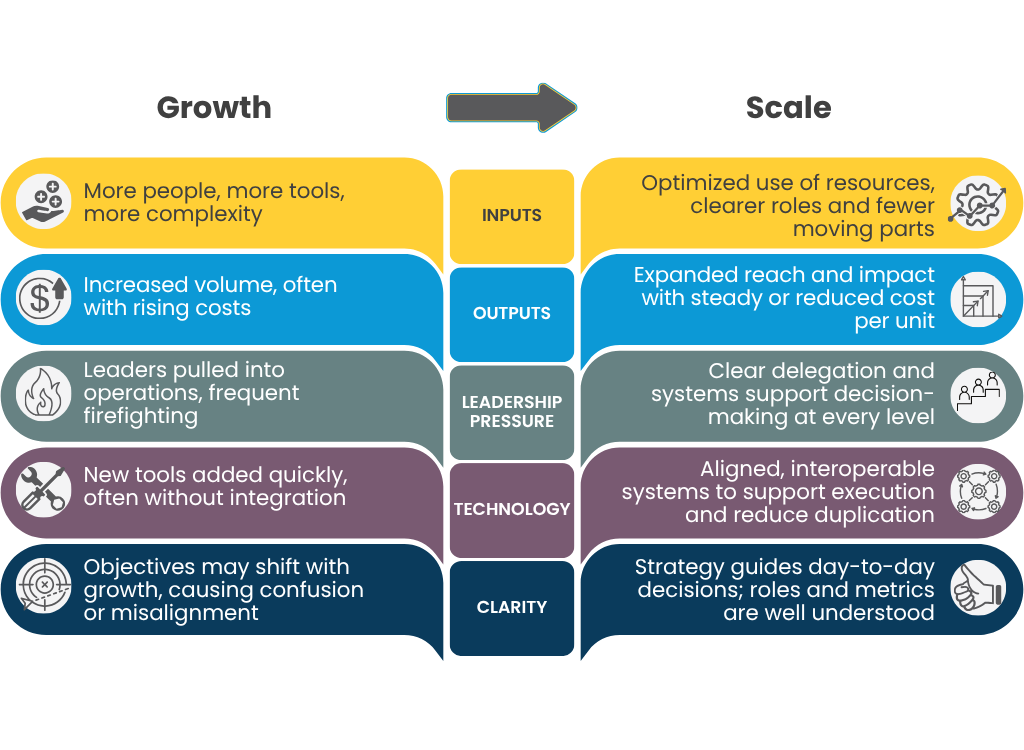
Now that we’ve clarified the difference between growth and scale, let’s explore what it takes to plan for scale — not just in theory, but in practice.
Explore more:
Is Your Organization Growing or Scaling?
Strategy is where you start. Scale is what you build.
Many organizations focus on setting goals, but few have a clear model for how to grow in a way that’s sustainable, resilient, and aligned. That’s where the architecture of scale comes in.
You’ve clarified your vision — but to scale effectively, strategy must do more than set direction. It must fuel the systems, people, and decisions that bring growth to life.
At Stratford, we’ve worked with organizations across sectors that struggle not with setting goals, but with delivering on them. That’s why we developed the Scale Advantage Framework — a practical model that simplifies the complexity of scale into two integrated phases: Strategy and Execution.
-
Phase 1: Cash & Strategic Clarity – Setting direction and securing the resources to fuel growth.
-
Phase 2: People, Process & Technology – Executing in a way that is repeatable, adaptable, and aligned.
.png?width=1250&name=simplified%20scale%20advantage%20(2).png)
Rather than treating scale as a one-time initiative, this approach helps organizations connect ambition to action in a way that’s sustainable and repeatable.
Scaling isn’t a phase — it’s a function of how your organization works, evolves, and delivers.
In the next section, we’ll explore how to turn this framework into an actual plan — one that evolves with you and prepares your team for execution.
Guide to Data Management & Data Governance
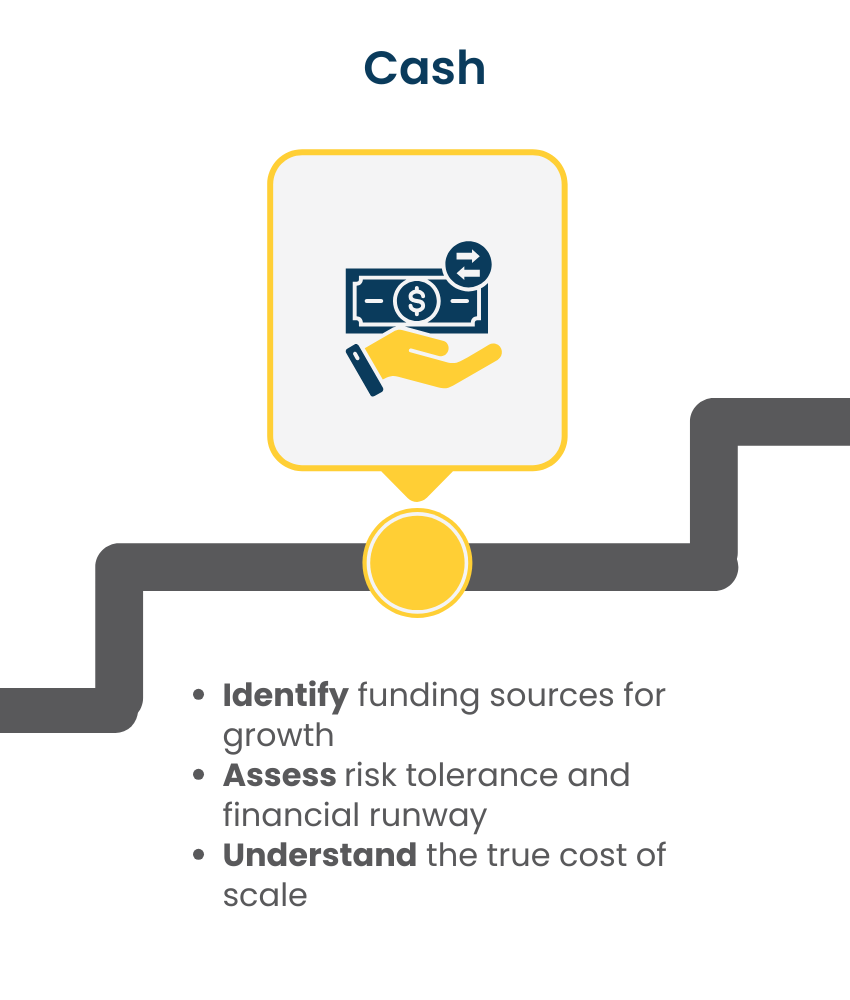
Cash
Sustainable scale requires upfront investment — whether through capital reserves, revenue reinvestment, or external funding. Understanding what growth will cost, where the money will come from, and how risk will be managed is essential. Without financial clarity, even the best strategy can overreach..
Explore more:
→ Setting Expectations for Growth & ProfitabilityStrategy
Great strategy starts with shared outcomes, realistic assumptions, and clearly defined success metrics. It sets direction, focuses resources, and connects high-level ambition to daily execution. But strategy that scales also accounts for complexity — preparing you to adapt as conditions change and decisions ripple across the organization.
Explore more:
→ What is the Right Strategic Planning Horizon?
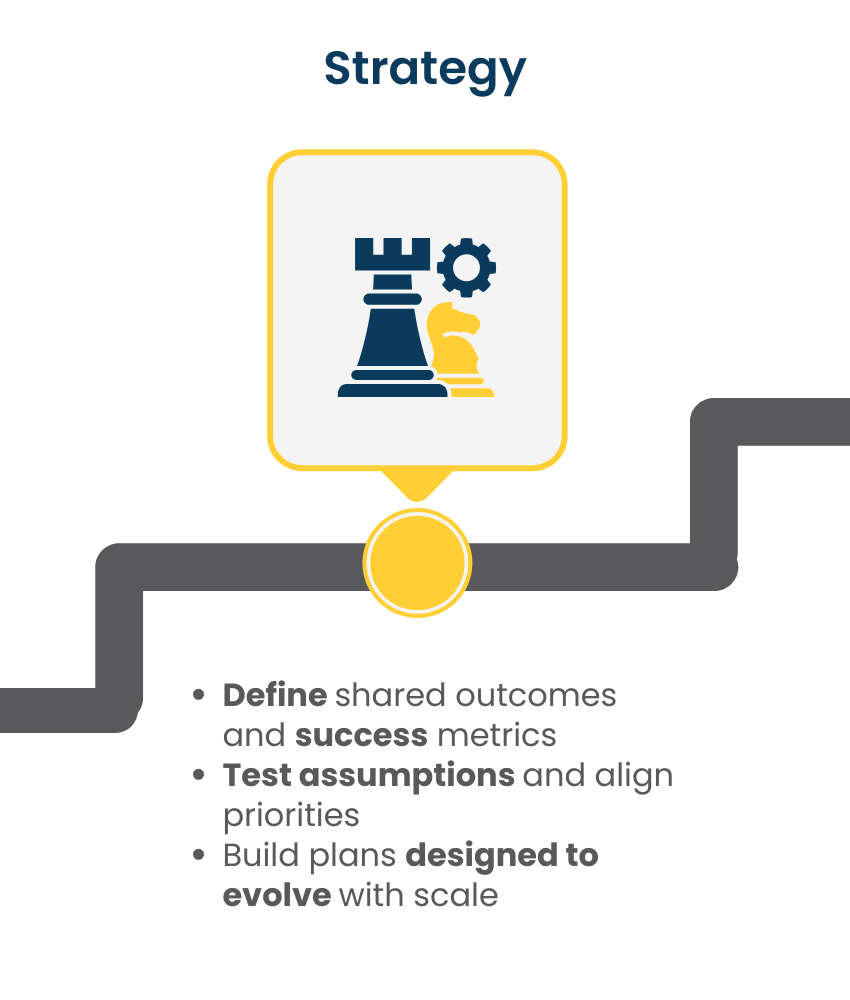
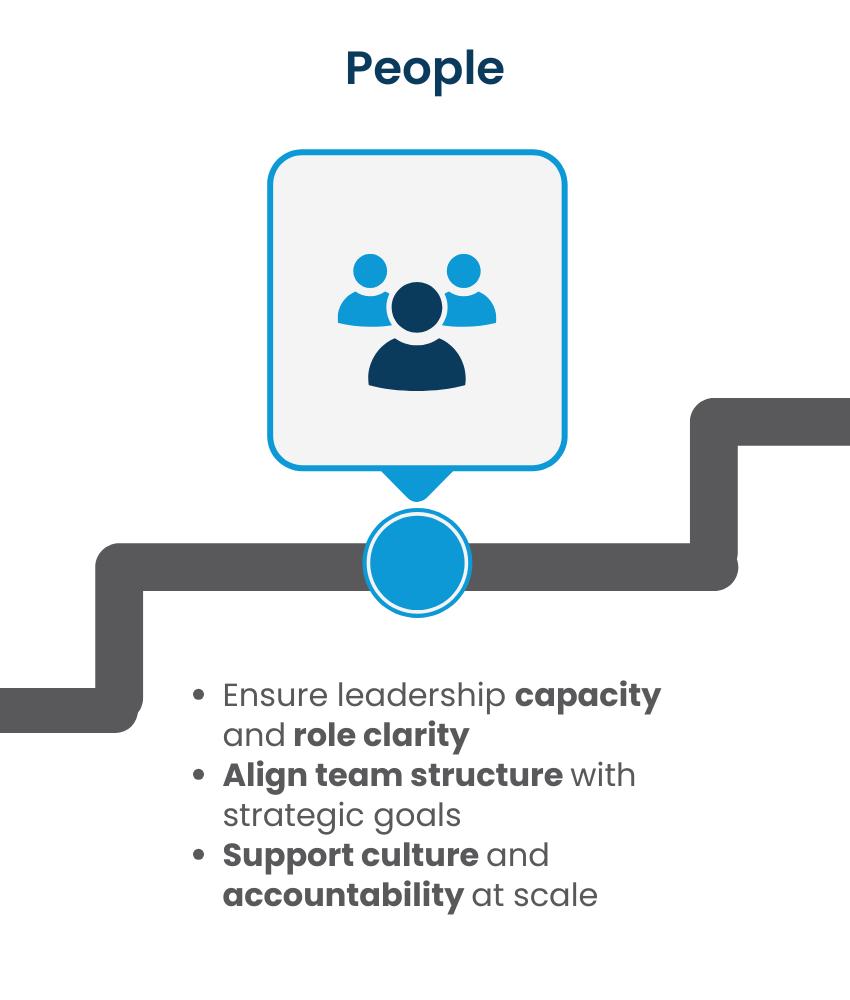
People
Your people strategy matters as much as your business strategy. Do you have the leadership capacity, role clarity, and team-wide alignment to drive execution? Growth puts pressure on talent and culture — and scaling without addressing this gap leads to burnout and stalled momentum.
Explore more:
→ Scaling Leadership Alongside Organizational Growth
Process
Scalable operations require more than hustle. Documented, repeatable processes reduce duplication, improve reliability, and set the foundation for expansion. When systems are unclear, execution becomes inconsistent — and scale breaks down.
Explore more:
→ Processes-The Foundation to Scaling Up
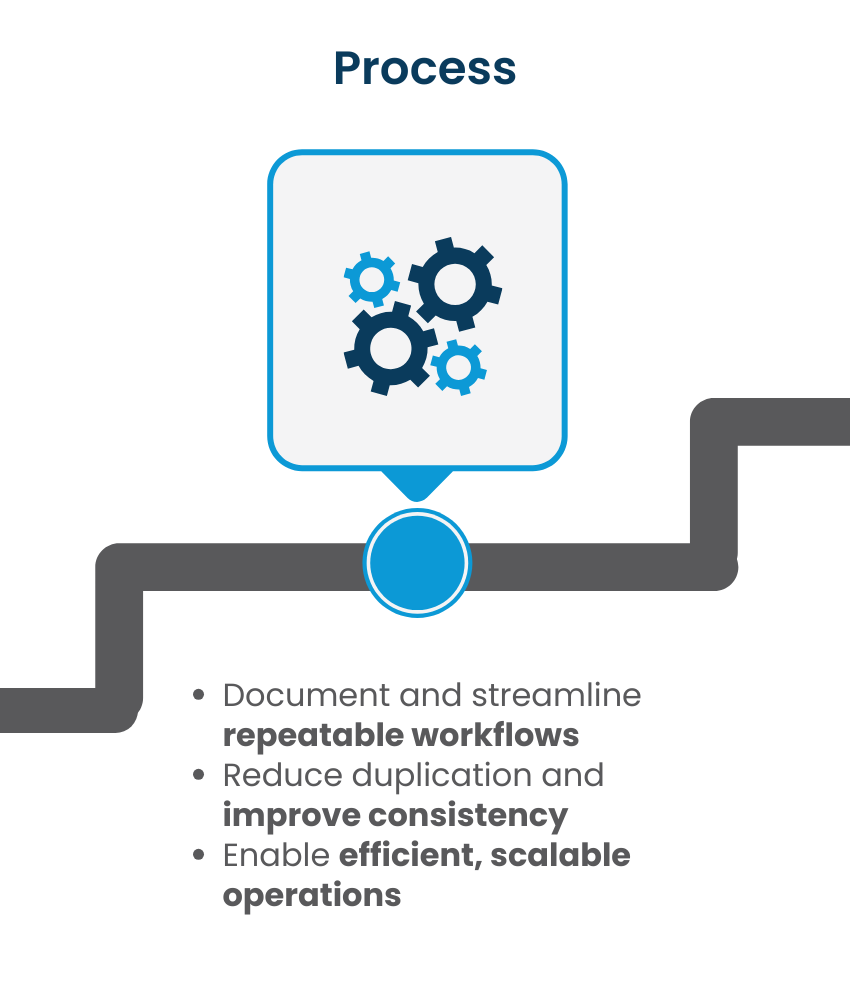
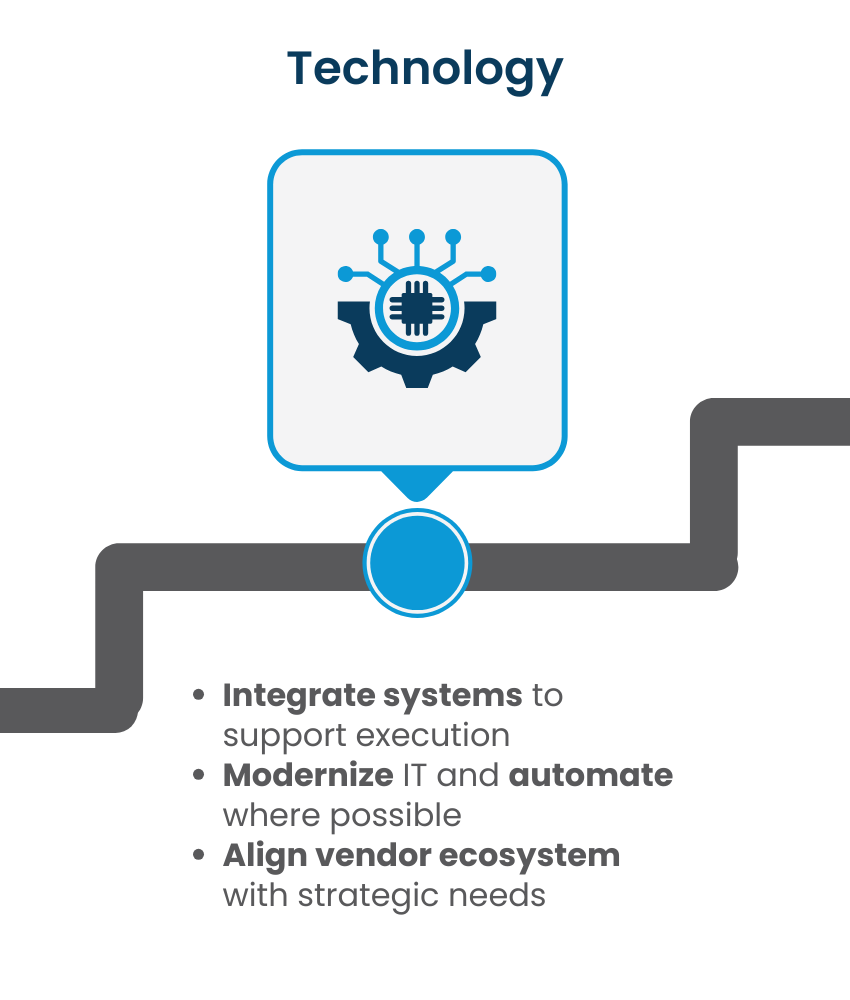
Technology
The right tools power scale. Whether you’re integrating platforms, modernizing infrastructure, or selecting vendors, your technology should enable growth — not slow it down. Strategic IT investment allows your team to work smarter, not harder.
Explore more:
→ Using Technology as an Enabler for Growth
→ Stratford Vendor Selection Services
→ Build or Buy
Unlock AI Potential
A good plan outlines your goals. A great one prepares you to grow into them.
Now that we’ve introduced the framework for scale, let’s explore how to build a plan that delivers on it. Planning for scale is about more than setting objectives — it’s about creating alignment, building in adaptability, and laying the foundation for execution.
This section walks through four critical components of scalable planning:
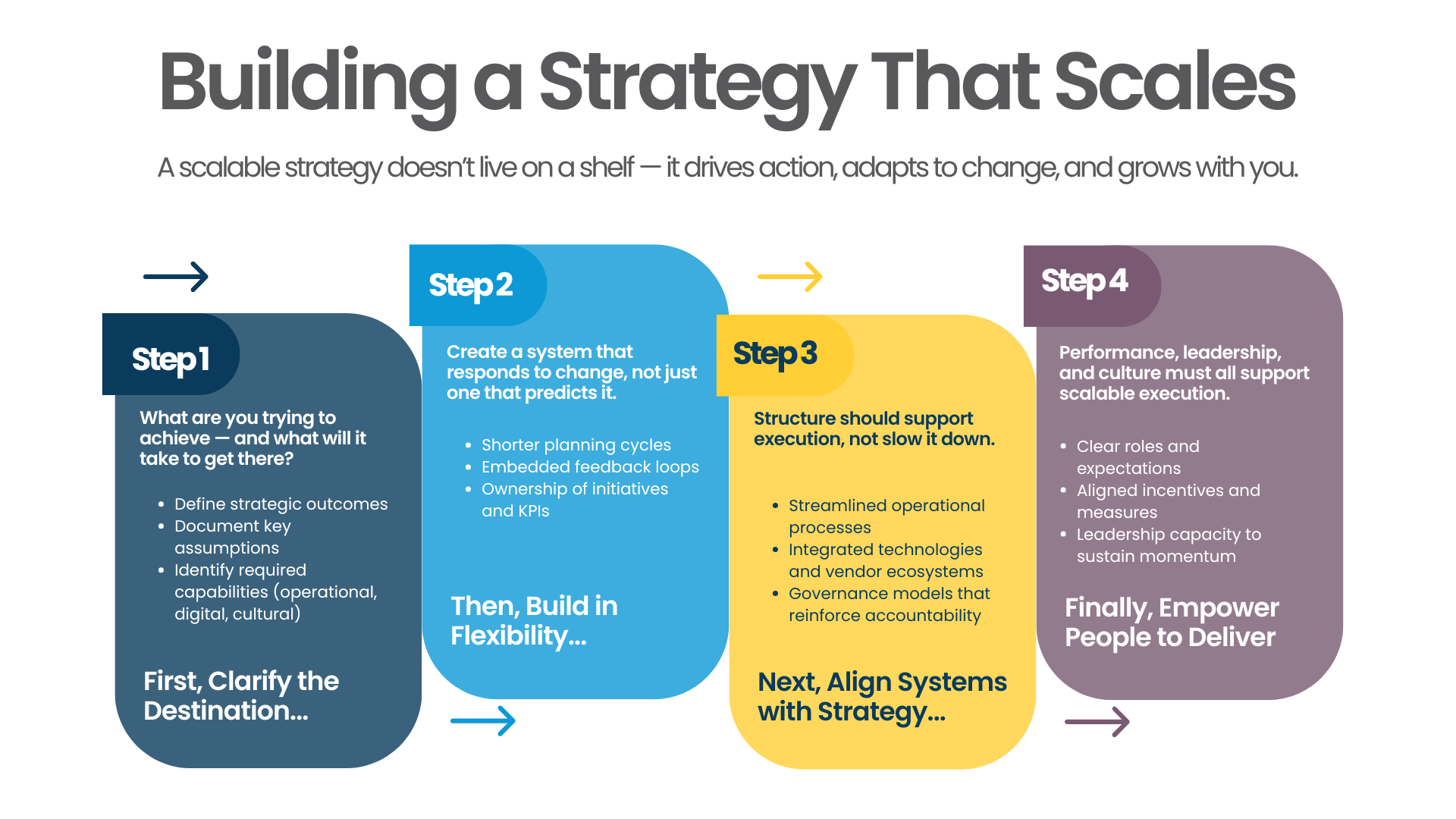
Clarify the Destination
Start by aligning your leadership team on the why, what, and how of scale.
- What are you really trying to achieve — and why now?
- What assumptions are you making about capacity, funding, or partners?
- What risks are you willing to take — and which ones need mitigation?
When everyone understands the destination and what success looks like, it becomes easier to make the right decisions and say no to distractions.
"Is everyone aligned on where you're headed — and why?"
Build in Flexibility
Static, annual plans fall short in dynamic environments.
Scalable plans must include mechanisms to revisit, refine, and course-correct. That means:
-
Quarterly strategic reviews tied to KPIs with the ability to realign if needed.
-
Decision logs to capture and track rationale
-
“Stoplight” check-ins to flag what’s working — and what’s not
Adaptability is what turns a strategy into a living system that evolves alongside your organization.
"Is your plan built to flex — or locked into a fixed path?"
Align Systems with Strategy
Structure should support execution — not slow it down.
That includes operational workflows, governance models, and enabling technologies that reinforce your goals. Without intentional design, the disconnect between what you plan and how you operate grows over time — eroding trust, consistency, and performance.
"Are your systems aligned with your strategy or working against it?"
Empower People to Deliver
Strategy lives or dies in the hands of your people.
Do they have the clarity, capacity, and confidence to deliver? That means aligning roles, decision rights, incentives, and leadership expectations so the entire organization can move in sync — especially during times of transition or growth.
These elements ensure that your plan becomes a living system — one that guides decisions, adapts to change, and prepares your organization to scale with confidence.
"Where do your people need more clarity or support to execute?"
Once your plan is built, you’ll need the right infrastructure to support it. That’s where systems and process optimization come in — and that’s what we’ll cover next.
Explore more:
Driving Digital Health Success
You don’t rise to the level of your strategy. You fall to the level of your systems.
Strategy sets the direction, but systems carry the weight. Without the right operational foundation, even the best-laid plans will buckle under the pressure of growth.
As you scale, repeatability, clarity, and efficiency become non-negotiable — and that’s where your systems, processes, and technologies need to rise to the occasion.
This section focuses on the operational layer of scale:
-
Designing processes that reduce duplication and increase accountability
-
Leveraging tech that enables, not complicates, execution
-
Continuously optimizing workflows to reduce friction and build resilience
Execution isn't where strategy ends, it's where it succeeds or fails.
How Processes Power Scale
1. Operational Clarity Prevents Chaos
Unclear processes lead to inconsistent outcomes, employee frustration, and wasted effort. Clear, documented workflows reduce duplication, increase accountability, and support onboarding and cross-functional collaboration.
2. Technology Should Accelerate, Not Complicate
Digital transformation is only effective when tech supports, rather than dictates, how your organization works. That means aligning tools with strategy, ensuring integrations are seamless, and avoiding tech debt from rushed decisions.
3. Systems Require Continuous Refinement
You don’t just “set and forget” business processes. Scalable organizations treat optimization as an continuous discipline — leveraging audits, automation, and data to identify opportunities and eliminate friction.
4. Process Maturity Enables Resilience
When systems are strong, your team can weather change, absorb growth, and focus on value creation — not firefighting. That’s the real ROI of operational excellence.
"What’s one friction point in your systems you could address this quarter?"
Key Takeaway
Processes aren’t just “operations problems” — they’re strategic assets. Optimizing how work gets done allows your team to focus energy where it matters most: executing your strategy and scaling your impact.
Explore more:
→ Processes: The Foundation to Scaling Up
→ How to Implement a Strategic Planning Model that Works
→ Execution: Strategy's Ugly Duckling
→ Cloud Watching: Optimizing Your IT Ecosystem
→ Business Execution: Getting Things Done
→ The Unwritten Rules of Strategy Execution
Developing an AI Checklist
AI isn’t a future initiative — it’s today’s competitive edge. But only if it’s aligned with strategy.
AI is no longer optional — it’s a multiplier. But its value depends entirely on how well it's embedded into strategy and operations.
Too often, AI adoption happens in silos, disconnected from core business goals, systems, or leadership buy-in. That’s how tech becomes a shiny side project, not a scalable solution.
At Stratford, we help organizations position AI as a strategic multiplier — integrated into planning, operations, and decision-making from day one.
How to Use AI Strategically
1. Start with Business Outcomes
The best AI use cases aren’t about what the technology can do — they’re about what your organization needs to achieve. From improving member experience to optimizing operations, AI must be grounded in outcomes that matter.
2. Assess Your Digital and Data Readiness
AI is only as good as the data and systems behind it. Without clean inputs and interoperable tech, AI outputs will stall or misfire.
3. Build Governance into AI Initiatives
Responsible AI isn’t just ethical — it’s efficient. Clear frameworks help manage risk, reinforce compliance, and align innovation with mission.
4. Enable Cross-Functional Execution
AI should enhance execution, not confuse it. That requires training, cross-team collaboration, and automation that supports — not disrupts — how work gets done.
"Are your AI efforts driving strategy — or distracting from it?"

Key Takeaway
AI is not a technology project. It’s a business capability — and one that’s rapidly defining which organizations can scale with agility, insight, and impact. Align it early, govern it wisely, and execute it well.
Explore more:
→ AI: Between Strategy and Execution
→ Beyond the Algorithm
→ Confidence Check
→ Supercharging Your Strategy with AI
→ Strategy and Leadership in the Era of AI and Organizational Purpose
→ Looking Behind the Curtain: Understanding AI's Potential and Impact
→ Data Management for a More Effective Organization
12 Obstacles Derailing Your Strategy
You’ve clarified your vision. You’ve designed a strategy that scales. Now comes the hard part: making it real.
Execution is where strategy either builds momentum — or breaks down. And it’s not usually the big-picture ideas that stall progress. It’s the overlooked assumptions, outdated systems, and fragmented decision-making that quietly create drag.
That’s because sustainable growth depends not just on vision — but on how well that vision is translated into action across people, processes, and technology.
From outdated governance to rushed vendor decisions, here are twelve common pitfalls that quietly erode execution. Some are structural. Some are cultural. All are avoidable — if you know what to look for.
If your strategy looks great on paper but you’re still not seeing the results you expected, this is the place to start.
"Which of these could be holding your team back — and how will you tackle it first?"
Treating Strategy as a Static Document
Letting your roadmap gather dust
Scaling Without Operational Readiness
Outgrowing your own systems
Underestimating Leadership Capacity
Bottlenecks at the top
Misaligned Culture and Metrics
Mixed messages and misfired incentives
Trying to Scale Everything at Once
Chronic overload
Tech Investments that Outpace Readiness
Tools before processes
Vendor Selection that Prioritizes Speed Over Fit
Short-term gain, long-term pain
Governance that isn't Built for Growth
Oversight that slows execution
Vendor & Tech Decisions Made in Isolation
Disconnected systems and duplication
Overcentralized Decision Making
Everything flows through the top
Digital Modernization Without Change Management
People left behind
Weak Cybersecurity Planning
Unprepared and exposed

